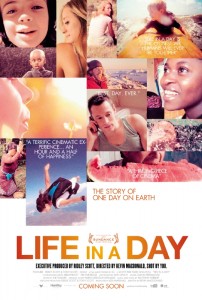[stextbox id=”grey” caption=”Life in a Day (2011)” float=”true” align=”right” width=”220″]
Director: Kevin Macdonald, Natalia Andreadis, Joseph Michael
Runtime: 95 minutes
Starring: Cindy Baer, Moica, Caryn Waechter, Jiraoki Aikawa
Studio: Transmission
Rating: Better Than Average Bear (?)
[/stextbox]
The phenomenon of web-based social networking, most notably through Facebook, Twitter and YouTube, has given everybody the ability to share their every waking moment with the world, whether we want them to or not. On the 24 July 2010, YouTube, director Kevin McDonald (State of Play, The Eagle) and Ridley Scott’s Scott Free Productions gave users the opportunity to use this power to upload a “glimpse of your life on camera”. The resulting footage from the Life in a Day Project would form the basis of the first major experiment in a user generated feature, using the most compelling footage from the submissions.
Choosing a single day, due to McDonald’s belief that “a day is the basic temporal building block of human life—wherever you are”, the majority of footage comes from user submissions from YouTube, each giving their personal observations on a single day. The remainder of the footage comes from cameras sent out to the developing world, to get a broader perspective on what life means around the world. Editing down 4500 hours worth of footage from 80,000 submissions in 140 nations around the world, the film acts as a giant mashup of YouTube clips.
Life in a Day may be the first time that Ridley Scott’s name appears alongside YouTube in the production credits, and it certainly is a bold experiment. User-generated content has transformed the web and social interaction in a way that didn’t seem possible over a decade ago, and emphasises that humans are by their very nature storytellers. Indeed, YouTube claims that over 48 hours worth of video is uploaded to their servers every minute, and the wealth of potential features here is limitless. Life in a Day doesn’t concentrate on the majority of the videos on YouTube, which mostly range from videos of kittens to videos of cats, but rather the personal accounts of those electing to submit videos. Therein lies some of the problems with Life in a Day, as it can’t completely claim to be an objective exploration of a day in the life of planet Earth, as the majority of the people have chosen to submit these videos. As such, this isn’t so much the voyeuristic side of YouTube as the exhibitionist one, and in some cases the footage is only an “average” day for somebody used to talking to or appearing on camera. Indeed, some of people appearing on the credits of IMDB have additional listings as short filmmakers, photographers or other industry professionals.
This isn’t true of all the footage of course. One particularly heartbreaking sequence comes from a Japanese father who looks after his young child in a messy capsule apartment, with their lives evidently having fallen apart with the death of his wife. A more local entry comes in the form of a dying man, candidly discussing his views on life. Similarly, the commissioned footage of developing and rural areas is a fascinating look at different cultures using the same observational power that could be found in this year’s Babies, and demonstrating that YouTube and user generated videos can be so much more than an extended Funniest Home Videos montage. There is skydiving, intimate moments and heartfelt confessions, although some of these feel less like a typical day than something for the cameras. Indeed, a final straight-to-camera piece laments that nothing particular special happened in her day, and one can’t help but feel that if the camera wasn’t there, the need for “something” to happen wouldn’t be so immediate.
Then again, finding meaning in nothingness is perhaps what Life in a Day is mostly about. McDonald’s considerable talents as a storyteller manages to hold these disparate elements together as a cohesive whole, and at the end of the day, viewers are going to interpret what they will from this crowd-sourced collection. These may not be typical elements in a day, but they did happen to hundreds of people around the world, and for the moment it is the closest we have to a truly user-generated movie.
[stextbox id=”custom” caption=”The Reel Bits”]A fascinating, if somewhat flawed and inconsistent, experiment in group storytelling. Now all we need is the YouPorn parody version.[/stextbox]
Life in a Day is released on 1 September 2011 in Australia from Transmission.
httpv://www.youtube.com/watch?v=w8S4gGI4nRo

